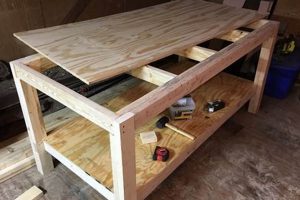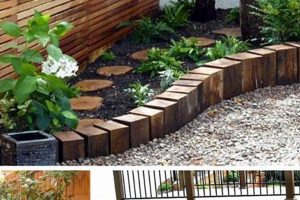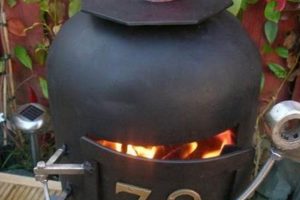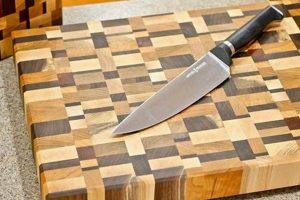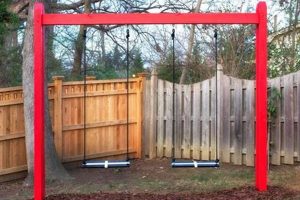The creation of a personal heated bathing vessel powered by a wood-burning stove, undertaken as a do-it-yourself project, represents a convergence of resourcefulness and a desire for off-grid relaxation. This endeavor involves constructing or adapting a watertight container, integrating a heat source external to the bathing area to avoid direct contact with fire, and establishing a water circulation system, often through thermosiphoning or a small pump. This project is commonly pursued by individuals seeking alternatives to conventional, electrically-heated hot tubs.
Such undertakings provide several advantages, including reduced reliance on electricity, potential cost savings on energy bills, and the satisfaction derived from a hands-on building project. Historically, wood-fired bathing has existed in various cultures, highlighting a long-standing connection between natural resources and personal hygiene/recreation. The contemporary resurgence of this practice reflects a growing interest in sustainable living and self-sufficiency.
The following sections will detail critical aspects of successfully realizing such a venture, including considerations for materials, stove selection, water safety, and legal compliance. Safety is paramount throughout the entire construction and operation phases, demanding careful attention to detail and adherence to best practices.
Essential Guidance for Wood-Fired Hot Tub Construction
The successful and safe implementation of a wood-fired hot tub project necessitates careful planning and execution. The following points offer critical guidance for individuals undertaking such a build.
Tip 1: Material Selection: Opt for durable, water-resistant materials for the tub construction. Cedar, redwood, and certain types of treated lumber are commonly employed. Ensure all materials are suitable for prolonged water exposure and high temperatures.
Tip 2: Stove Placement and Safety: Position the wood-burning stove at a safe distance from flammable materials and the tub itself. Proper ventilation is essential to prevent carbon monoxide buildup. A heat shield may be necessary to mitigate radiant heat.
Tip 3: Water Circulation: Implement a reliable water circulation system. Thermosiphoning is a passive method, but a small, submersible pump can enhance water movement and temperature distribution throughout the tub.
Tip 4: Water Treatment: Establish a water treatment regimen to maintain hygiene and prevent algae growth. Chemical sanitizers, such as chlorine or bromine, may be necessary. Consider alternative methods, such as ozone or UV systems, but research their effectiveness and suitability.
Tip 5: Structural Integrity: Ensure the structural integrity of the tub and its supporting framework. The tub must be capable of withstanding the weight of the water and occupants without risk of collapse or leakage. Reinforce joints and connections as needed.
Tip 6: Regulatory Compliance: Investigate local building codes and regulations pertaining to hot tubs and wood-burning appliances. Obtain necessary permits prior to commencing construction. Compliance is essential to avoid legal issues and ensure safety.
Tip 7: Temperature Monitoring: Install a reliable thermometer to monitor water temperature. Avoid overheating the water, as this poses a scalding hazard. A temperature gauge allows for precise control of the heating process.
These guidelines underscore the importance of careful planning, sound construction practices, and a commitment to safety. A well-executed project offers numerous benefits, including relaxation, recreation, and a reduced environmental impact.
The subsequent sections will address considerations for ongoing maintenance and long-term operational best practices.
1. Material Selection
The selection of materials is paramount in any undertaking that involves constructing a wood-fired hot tub. This decision directly influences the project’s overall durability, safety, and long-term operational costs. Inadequate material selection can result in premature structural failure, water contamination, or inefficient heat retention, undermining the viability of the entire effort. For instance, utilizing untreated lumber for the tub itself leads to rot and eventual collapse, requiring costly repairs or complete reconstruction. Similarly, using unsuitable metals for the stove can result in corrosion and potential leakage of harmful substances into the water.
Considerations for material selection extend beyond mere cost. Water resistance, thermal properties, and chemical compatibility are crucial factors. Rot-resistant woods, such as cedar or redwood, are commonly favored for tub construction due to their natural ability to withstand prolonged water exposure. Stainless steel is often preferred for the stove’s firebox and heat exchanger due to its high heat tolerance and resistance to corrosion. The selection of plumbing materials must also account for temperature fluctuations and potential chemical interactions with water treatment products. Ignoring these aspects can compromise water quality and user safety.
Therefore, careful consideration of material properties is not merely a superficial detail, but a fundamental requirement for success. The impact of informed material choices manifests in the project’s extended lifespan, reduced maintenance requirements, and enhanced user experience. While initially more expensive, employing durable and suitable materials ultimately minimizes long-term costs and maximizes the benefits of such do-it-yourself construction. This upfront investment guarantees an improved and sustainable construction project.
2. Stove Efficiency
The efficiency of the wood-burning stove directly impacts the viability and sustainability of any wood-fired hot tub endeavor. A less efficient stove necessitates a greater consumption of wood to achieve the desired water temperature, increasing fuel costs and the environmental impact. Conversely, a highly efficient stove minimizes wood usage, reduces emissions, and provides a more consistent and controllable heating experience. The selection of a stove with appropriate thermal characteristics is, therefore, a critical component of responsible construction.
Examples of inefficiency stemming from inappropriate stove selection are plentiful. An oversized stove, while capable of rapid heating, may lead to overheating and difficulty in maintaining a comfortable bathing temperature, resulting in wasted fuel and potential safety hazards. A stove that is too small, on the other hand, may struggle to reach the desired temperature, particularly in colder climates, leading to prolonged heating times and excessive wood consumption. Furthermore, the stove’s design plays a significant role; stoves with advanced combustion technologies, such as secondary air injection, burn wood more completely, extracting more heat from each log and reducing particulate emissions. This illustrates that the stove serves as the central regulator of the whole system.
In summary, optimizing stove efficiency is not merely a matter of convenience but a fundamental aspect of responsible design and operation. Investing in a well-engineered, appropriately sized stove minimizes environmental impact, reduces operating costs, and enhances the overall enjoyment and sustainability of the hot tub experience. This attention to detail ensures it remains a worthwhile endeavor.
3. Water Safety
Water safety constitutes a critical consideration within the context of personal hot tub construction. Unlike commercially manufactured units with integrated filtration and sanitation systems, do-it-yourself projects demand proactive management of water quality. The potential for bacterial contamination, scalding, and chemical imbalances necessitates careful planning and consistent maintenance.
- Bacterial Contamination Control
Unsanitized water provides a breeding ground for bacteria, including Legionella and Pseudomonas, posing significant health risks. Regular disinfection, typically via chlorine or bromine, is essential to maintain safe bacterial levels. Test kits are indispensable for monitoring sanitizer concentrations and ensuring they remain within recommended ranges. Water changes, conducted periodically, help to dilute accumulated contaminants and further reduce bacterial loads.
- Temperature Regulation and Scalding Prevention
Wood-fired heating systems lack the precise temperature control of electric heaters. Overheating can rapidly occur, presenting a severe scalding hazard. A reliable thermometer is essential for monitoring water temperature, and users must exercise caution when adding fuel to the stove. Implementing a mixing valve can temper the water before it enters the tub, mitigating the risk of burns. Clear communication regarding safe temperature limits is also vital.
- Chemical Balance and Water Chemistry
Maintaining proper pH levels is crucial for sanitizer effectiveness and user comfort. Imbalanced pH can lead to skin irritation, corrosion of metal components, and reduced sanitizer potency. Regular testing of pH, alkalinity, and calcium hardness is necessary to maintain optimal water chemistry. Adjustments should be made using appropriate chemicals according to manufacturer instructions.
- Filtration and Debris Removal
Wood-fired hot tubs are susceptible to accumulating organic debris, such as leaves, insects, and ash. This debris not only detracts from the aesthetic appeal but also provides nutrients for bacterial growth. A filtration system, even a simple one utilizing a submersible pump and filter, helps to remove particulate matter. Regular skimming and vacuuming further contribute to maintaining water clarity and hygiene.
Collectively, these facets of water safety underscore the importance of diligence and informed decision-making. Prioritizing water quality safeguards user health and ensures the long-term viability of such construction. Neglecting these considerations can transform a source of relaxation into a potential hazard, negating the benefits of the initial investment.
4. Structural Integrity
Structural integrity constitutes a cornerstone of any safe and functional wood-fired hot tub undertaking. The ability of the structure to withstand hydrostatic pressure, temperature fluctuations, and the dynamic loads imposed by occupants directly impacts its longevity and the safety of its users. Compromised integrity can lead to catastrophic failure, resulting in significant property damage and potential injury.
- Foundation Stability
A stable foundation is paramount for distributing the substantial weight of a filled hot tub. Uneven settling or inadequate support can induce stress cracks in the tub walls, leading to leaks and eventual collapse. A level, compacted gravel base or a reinforced concrete pad is generally recommended to provide a solid and uniform foundation. Proper drainage should also be incorporated to prevent water accumulation around the base, which can undermine its stability over time. Inadequate foundations result in uneven pressure, cracks, and structural breakdown.
- Wall Reinforcement
The walls of a wood-fired hot tub must be adequately reinforced to resist the outward pressure exerted by the water. Without sufficient reinforcement, the walls can bulge, warp, or even rupture. External banding, internal bracing, or the use of thicker materials can enhance wall strength. The specific reinforcement method should be chosen based on the size and shape of the tub, as well as the material used for construction. Improper reinforcement leads to deformation and ultimately structural failure.
- Joint Integrity
The joints between the individual components of the tub represent potential weak points in the structure. Leaks, caused by improperly sealed or inadequately fastened joints, can compromise the structural integrity over time. The selection of appropriate sealants and fasteners is crucial. High-quality, waterproof adhesives and corrosion-resistant hardware should be used to ensure a durable and leak-proof connection. Regular inspection and maintenance of joints are essential to identify and address any signs of deterioration before they escalate. Poorly constructed joints invite water damage and gradual structural weakening.
- Material Durability
The inherent durability of the materials used in construction contributes significantly to the overall structural integrity. Rot-resistant woods, such as cedar or redwood, are favored for their ability to withstand prolonged water exposure. Using treated lumber protects against decay. However, the treatment chemicals must be non-toxic and safe for prolonged human contact. The quality of the materials and the skill with which they are assembled contribute to the longevity of the project.
In conclusion, maintaining structural integrity demands a holistic approach encompassing careful foundation preparation, adequate wall reinforcement, robust joint construction, and the use of durable materials. Neglecting any one of these aspects can compromise the overall stability and longevity. The pursuit of this undertaking demands unwavering attention to detail to ensure a safe and enjoyable experience.
5. Site Preparation
Site preparation represents a foundational step in the successful execution of any wood-fired hot tub project. The chosen location directly impacts ease of access, drainage, safety, and overall aesthetic integration within the landscape. Inadequate site preparation often results in functional issues, structural instability, and increased maintenance requirements, ultimately detracting from the intended benefits. A poorly prepared site creates a ripple effect, complicating subsequent construction stages and potentially leading to costly remediation efforts. For example, neglecting to level the ground prior to construction may result in uneven weight distribution, stressing the tub’s structure and potentially leading to leaks or even collapse. Similarly, insufficient drainage can cause water accumulation around the base, promoting rot and attracting pests.
Specific considerations for site preparation include soil type, proximity to utilities, prevailing wind direction, and fire safety regulations. Clay-rich soils, for instance, require more extensive drainage measures compared to sandy soils. The presence of underground pipes or overhead power lines necessitates careful planning to avoid accidental damage during excavation. Positioning the hot tub upwind from prevailing winds can minimize smoke exposure. Adherence to local fire safety codes, including setbacks from combustible structures, is essential to prevent the risk of accidental fires. The practical application of these considerations involves conducting a thorough site assessment, obtaining necessary permits, and implementing appropriate landscaping and infrastructure improvements. For example, a gravel base provides excellent drainage, while a concrete pad offers a stable and level surface. Strategic placement of landscaping elements can enhance privacy and create a more aesthetically pleasing environment.
In conclusion, site preparation is not merely a perfunctory task but an integral component of a wood-fired hot tub project. Proper planning and execution minimize potential problems, optimize functionality, and enhance the overall enjoyment. Overlooking this step introduces unnecessary risks and compromises the long-term viability of the project, highlighting the importance of thorough planning and thoughtful execution.
6. Regulatory Compliance
The construction of a wood-fired hot tub as a do-it-yourself project is subject to a complex web of local, regional, and potentially national regulations. Adherence to these regulations is not merely a bureaucratic formality, but a critical aspect of ensuring safety, environmental protection, and legal operation. Failure to comply can result in fines, legal action, and the forced removal of the structure, rendering the entire project a costly and unusable endeavor.
- Building Codes and Permits
Most jurisdictions require building permits for the construction of any permanent structure, including hot tubs. These permits ensure that the construction adheres to established safety standards, encompassing structural integrity, electrical wiring (if applicable), and plumbing connections. Building codes may specify requirements for foundation construction, wall materials, and safety barriers, such as fencing. Ignorance of these codes can lead to non-compliance and the rejection of the project. Compliance with building codes ensures the structural soundness and safety of the installation.
- Fire Safety Regulations
Given the presence of an open flame, wood-fired hot tubs are subject to stringent fire safety regulations. These regulations typically dictate minimum distances from combustible materials, requirements for spark arrestors on stove chimneys, and the presence of fire extinguishers. Local ordinances may also restrict the use of wood-burning appliances during periods of high fire risk or impose limitations on the type of wood that can be burned. Adherence to these regulations minimizes the risk of accidental fires and protects surrounding property.
- Water Quality and Sanitation Standards
Many jurisdictions have regulations pertaining to the disposal of hot tub water, particularly if chemical sanitizers are used. Improper disposal can contaminate groundwater or surface water sources. Regulations may require dechlorination of the water prior to discharge or restrict the types of chemicals that can be used for sanitation. Additionally, some areas may have regulations concerning the water source used to fill the hot tub, particularly if well water is involved. Compliance with these standards protects water resources and public health.
- Zoning Ordinances and Property Restrictions
Zoning ordinances dictate how land can be used and may impose restrictions on the placement of structures, including hot tubs. Property restrictions, such as those imposed by homeowner associations, may further limit the size, location, or appearance of hot tubs. It is essential to review zoning ordinances and property restrictions prior to commencing construction to ensure that the project is permissible and does not violate any existing regulations. Non-compliance can lead to legal disputes and the forced removal of the structure. Thorough research on laws minimizes future problems.
In essence, regulatory compliance is an indispensable element of such do-it-yourself construction, requiring proactive investigation and adherence to a complex set of rules. Addressing these legal requirements early in the planning process is crucial for avoiding costly mistakes and ensuring the long-term viability and legal permissibility of the endeavor. Disregarding or neglecting the regulatory landscape can undermine all the effort and investments made. The careful application of these regulations ensures construction remains compliant and safe for use.
Frequently Asked Questions
The following questions address common concerns and misconceptions surrounding the construction of a wood-fired hot tub through do-it-yourself methods. These responses aim to provide clear and informative guidance.
Question 1: Is specialized expertise required to undertake such a project?
While prior experience in carpentry, plumbing, and metalworking is beneficial, it is not strictly necessary. However, a thorough understanding of basic construction principles and a willingness to learn are essential. Complex aspects, such as stove design or electrical connections, may warrant consultation with qualified professionals.
Question 2: What are the primary safety considerations during construction and operation?
Safety must be paramount. This involves ensuring structural stability, preventing scalding through temperature regulation, mitigating fire hazards through proper stove placement and chimney design, and maintaining water quality through sanitation and filtration. Regular inspection and maintenance are essential for continued safe operation.
Question 3: How does the cost compare to purchasing a commercially manufactured hot tub?
The initial cost can be lower, particularly if using recycled materials or constructing a simpler design. However, factoring in the cost of materials, tools, and potential professional assistance is important. Furthermore, consider the ongoing expenses of wood fuel, water treatment chemicals, and maintenance, which can accumulate over time.
Question 4: What materials are best suited for constructing the tub itself?
Rot-resistant woods, such as cedar or redwood, are commonly favored due to their natural ability to withstand prolonged water exposure. However, treated lumber, stainless steel, and certain types of durable plastic can also be used. Selecting materials that are non-toxic, heat-resistant, and compatible with water treatment chemicals is essential.
Question 5: How can water temperature be effectively regulated without automated controls?
Temperature regulation requires diligent monitoring and manual adjustments. A reliable thermometer is essential. Smaller, more frequent additions of wood fuel provide finer control than large, infrequent additions. Mixing valves and circulation pumps can help to distribute heat evenly and prevent localized overheating.
Question 6: What maintenance is required to ensure longevity and hygiene?
Regular cleaning, including skimming debris and scrubbing surfaces, is essential. Water changes should be performed periodically to dilute accumulated contaminants. The stove and chimney must be inspected and cleaned regularly to prevent creosote buildup. Joints and seals should be inspected for leaks and repaired as needed. Proper water treatment protocols must be followed to maintain sanitation.
Careful planning, meticulous execution, and ongoing maintenance are essential for a successful and safe construction. Adherence to established safety guidelines and best practices is crucial for realizing the intended benefits.
The subsequent section will explore alternative design options and innovative approaches to construction.
Conclusion
The preceding exploration of wood fired hot tub diy has elucidated critical aspects of planning, construction, safety, and regulatory compliance. These considerations underscore the complexity inherent in undertaking such a venture. Successfully integrating the elements of structural integrity, efficient heating, and water safety necessitates a meticulous approach. Prudence dictates a comprehensive understanding of the potential challenges and a commitment to adhering to established best practices.
Prospective builders are encouraged to prioritize safety and regulatory compliance above all else. The successful implementation of this undertaking depends on diligent planning and execution, the benefits of which extend beyond mere recreational utility. The emphasis remains on responsible construction practices and the promotion of safe usage. The future of wood-fired hot tub construction relies on continued innovation and the dissemination of accurate information to ensure both safety and sustainability.


